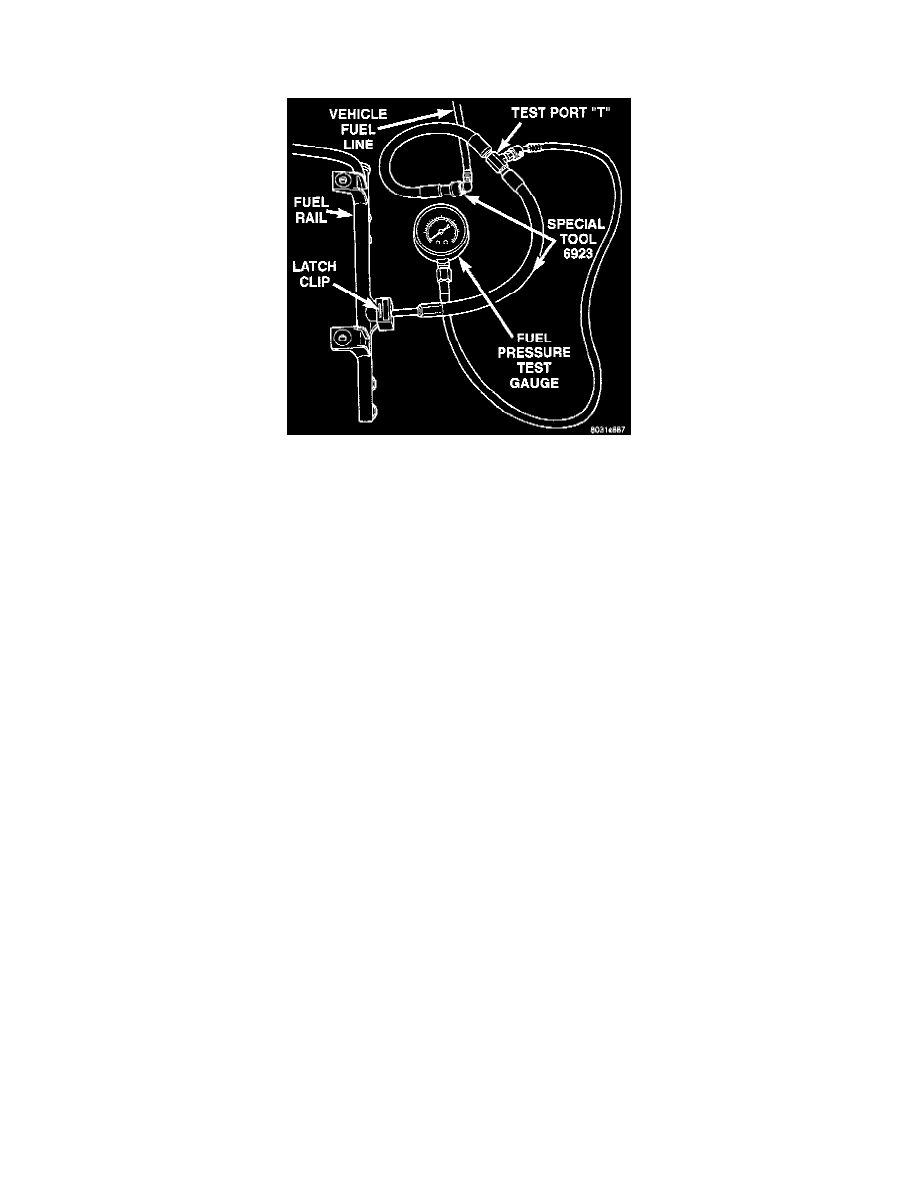Dakota 4WD V6-3.9L VIN X (1997)

Fuel Pressure: Testing and Inspection
Fuel Pressure Test - Without Test Port
Fig 10 Installing Adapter Tool And Pressure Gauge
WARNING: THE FUEL SYSTEM IS UNDER CONSTANT FUEL PRESSURE EVEN WITH THE ENGINE OFF. BEFORE
DISCONNECTING FUEL LINE AT FUEL RAIL, THIS PRESSURE MUST BE RELEASED. REFER TO THE FUEL SYSTEM PRESSURE
RELEASE PROCEDURE.
NOTE: Use this test in conjunction with the Fuel Pump Capacity Test and Fuel Pressure Leak Down Test.
Check Valve Operation: The electric fuel pump outlet contains a one-way check valve to prevent fuel flow back into the tank and to maintain fuel
supply line pressure (engine warm) when pump is not operational. It is also used to keep the fuel supply line full of gasoline when pump is not
operational. After the vehicle has cooled down, fuel pressure may drop to 0 psi (cold fluid contracts), but liquid gasoline will remain in fuel supply
line between the check valve and fuel injectors. Fuel pressure that has dropped to 0 psi on a cooled down vehicle (engine off) is a normal condition.
When the electric fuel pump is activated, fuel pressure should immediately rise to specification.
All fuel systems are equipped with a fuel tank module mounted, combination fuel filter/fuel pressure regulator. The fuel pressure regulator is not
controlled by engine vacuum.
Procedure
1. Release fuel pressure. Refer to the Fuel System Pressure Release Procedure-Without Pressure Test Port.
2. Disconnect latch clip and fuel line at fuel rail. Refer to Quick-Connect Fittings for procedures.
3. Connect adapter tool number 6923 into the fuel rail (Fig. 10). Be sure adapter tool is fully seated into fuel rail.
4. Install latch clip to fuel rail. If latch clip can not be fully seated into fuel rail, check for adapter tool not fully seated to fuel rail.
5. Connect vehicle fuel line into adapter tool 6923 (Fig. 10). Be sure fuel line is fully seated into adapter tool 6923.
6. Remove protective cap at test port "T" on adapter tool number 6923.
7. Connect the 0-414 kPa (0-60 psi) fuel pressure gauge (from gauge set 5069) to the test port "T" (Fig. 10).
8. Start engine and note pressure gauge reading. Fuel pressure should be 339 kPa +/- 34 kPa (49.2 psi +/- 5 psi) at idle.
9. If engine runs but pressure is below 44.2 psi, check for a kinked fuel supply line somewhere between fuel rail and fuel pump module. If line is not
kinked, replace fuel pump module assembly. Refer to Fuel Pump Module Removal/Installation.
10. If operating pressure is above 54.2 psi, electric fuel pump is OK, but fuel pressure regulator is defective. Replace fuel filter/fuel pressure
regulator. Certain filter/regulators may be serviced separately and some require the replacement of the fuel pump module assembly. Refer to Fuel
Filter/Fuel Pressure Regulator Removal/Installation for more information.
11. After performing pressure test, install fuel line into fuel rail. Install latch clip into fuel rail.
